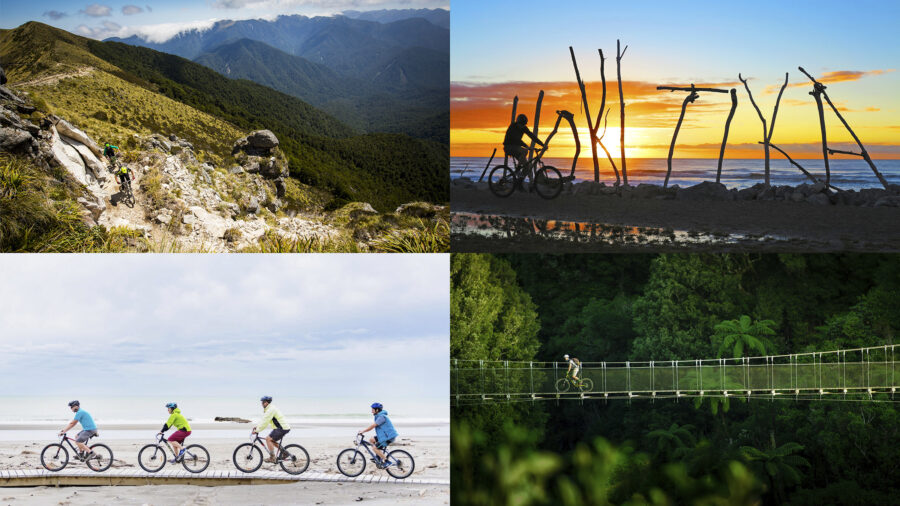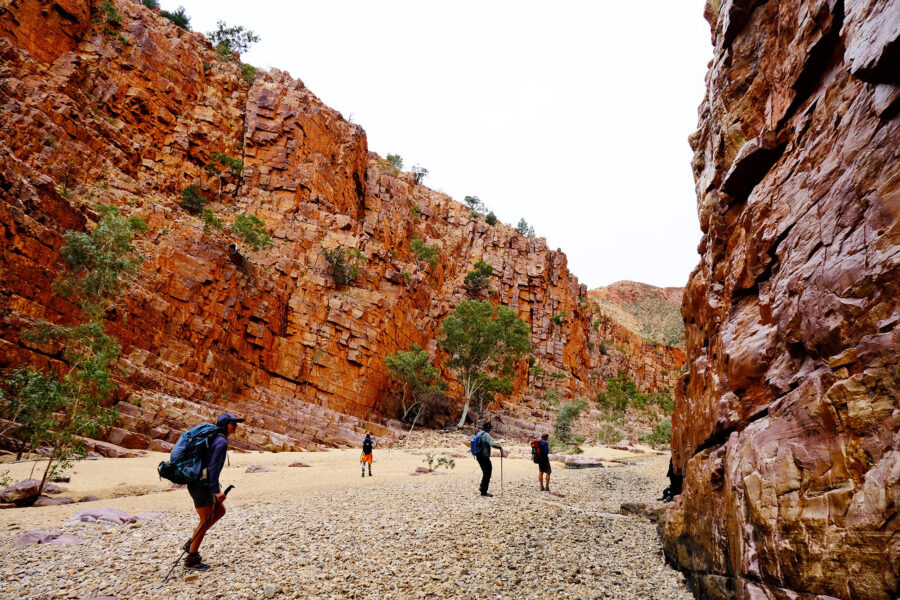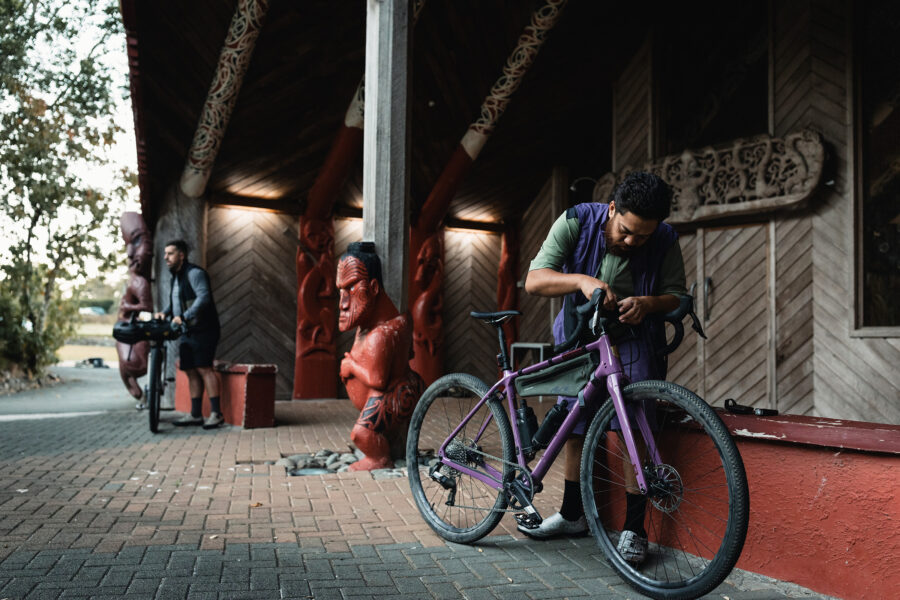Six of Victoria’s best adventure spots
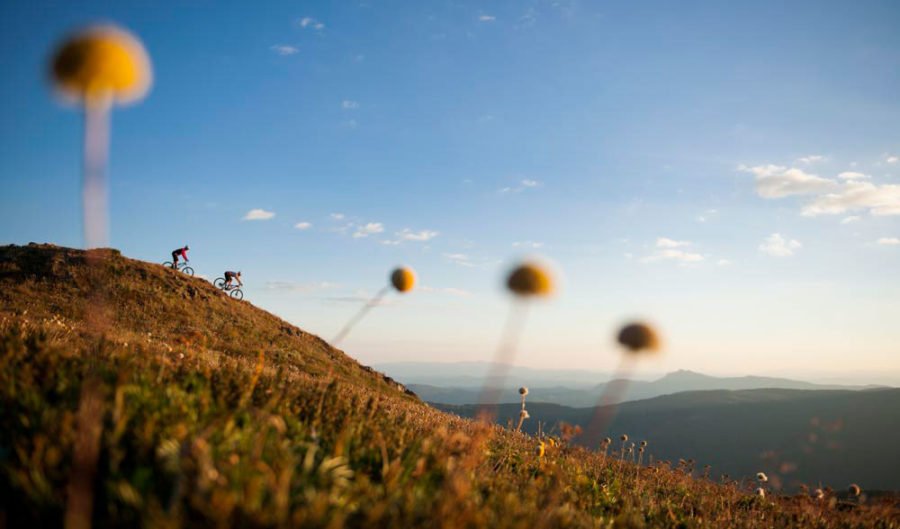
1. Hiking: Croajingalong National Park
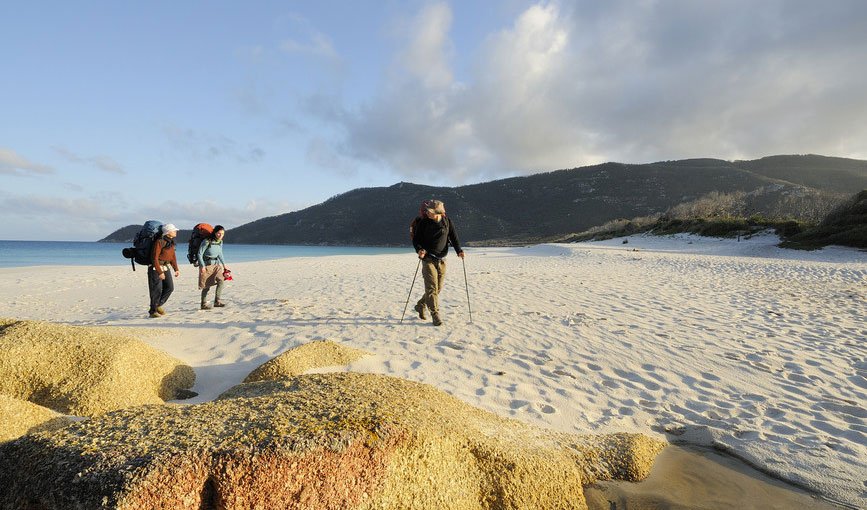
Hikers at Wilsons Promontory. (Photo credit: Gavin Hansford)
Recommend: From September-May.
THE WILDERNESS COAST WALK, hugging the north-east coastline of Victoria, is one of Australia’s premier multiday coastal tracks, taking walkers from Croajingalong National Park’s eastern point of Sydenham Inlet to – if you venture into NSW – Wonboyn, in the Nadgee Nature Reserve. For those keen to stick to the Victorian side, your finish point is either the coastal village of Mallacoota, where you can further indulge in paddling, swimming or fishing, or you could camp for your last night next to the freshwater-filled Lake Barracoota, a small campsite around four hours north of Mallacoota.
We’d opt to finish at Mallacoota only because it is easier logistically; the campsite at Lake Barracoota is walk-access only, and you would then have to loop inland and join some 4WD tracks back to the shores of Lake Mallacoota to catch a boat back to town.
The hike is magic, passing as it does through a section of coastline that is one of the best examples of an intertidal sand dune system (the result of often-powerful offshore winds). The walk is intermediate-advanced in terms of grading, with multiday, self-sufficient hiking experience a must – and be prepared to get your boots wet at some tidal crossings (check tide charts beforehand) and often full of sand. The rewards are many however, with the numerous campsites dotted along the coast all offering sublime views of the roaring Pacific Ocean. Other highlights include the coastal cliffs between Sandpatch Point and Shipwreck Creek, sea caves, the contrast between the sandy landscape and the coastal heathlands, and the historical Point Hicks Light Station.
There is a booking system now in place for the Wilderness Coast Walk (groups larger than eight are not permitted) but it is easy to obtain permits by going to www.parks.vic.gov.au/stay or ringing Parks Victoria on 13 19 63. You should also have all the topo maps, tide charts, take an EPIRB (there’s no mobile reception) and have done a proper weather check beforehand as this part of the east coast can cop a hammering in wild weather. It’s a remote adventure, with parts of the track likely to be overgrown or hard to follow, and no signposts, so make sure you’re confident in your navigational skills. The weather is also volatile, no matter the season, so pack appropriately. Water is also a scarcity at different times during the year, so ensure you have plenty of water in your packs and, again, check with Parks Victoria as to the current water availability before your walk – and take a water filtration system.
The walk offers the chance to experience one of the still-wild parts of this country; the national park’s biodiversity (there are more than 1000 native plant species, 306 bird species and 52 mammal species found in the park) and the rich indigenous history (you will spot shell middens throughout your journey) means you should take your time. The campsites are perfectly spaced out to ensure there’s no need to rush. These sites are basic (there are only a few toilets along the way) so make sure you adhere to Leave No Trace practices when it comes to human waste and food scraps.
There are some vehicular access points along the walk to different campsites so if you cannot spare a lot of time you can still enjoy this beautiful part of Australia. We’d definitely recommend a night or two at these sites with the family as it’s a brilliant way to introduce young’uns to this often-overlooked but truly spectacular part of Victoria.
visitvictoria.com/Gippsland; parksweb.vic.gov.au
2. Paddling: Gippsland Lakes

Regardless of your paddling experience, there is a paddling location in Gippsland Lakes that will cater for it. (Photo credit: Tourism Victoria)
Recommend: All year
Australia’s largest enclosed waterway – otherwise known as the Gippsland Lakes – is actually a combination of three lakes: King, Victoria and Wellington. Fed by a number of freshwater rivers, and accessed via tourist towns such as Paynesville, Metung, Loch Sport and Lakes Entrance, this part of Victoria’s southeast is a magnet for sea kayakers and canoeists. The vast size of the place in terms of how much there is to paddle (estimated to be around 600 square kilometres of waterway fed by seven freshwater rivers), is only matched by its variety, which is its biggest appeal. Regardless of your paddling experience, there is a paddling location in this area that will cater for it. And it’s all only four hours east of Melbourne.
The sheltered lakes and lagoons (such as Victoria Lagoon) make for a great learning ground thanks to the minimal effect of the tide ensuring calm water, while for the more experienced, there is the chance to test their open ocean skills by paddling out through Entrance Bay, at the easternmost point of 80km-long Lake Victoria, into the Ninety Mile Beach Marine National Park’s open coastal waters.
The Gippsland Lakes Coastal Park has a number of campsites dotted along the lakefront, including some awesome bush camping sites accessible via watercraft (be aware you are sharing these waters with powered boats). Some of the best ones include Spoon Bay and Red Bluff, at the western end of Lake Victoria, and the campsite at Rotamah Island – one of the best bush campsites in Oz, if you ask us, and only matched by some of the water-access-only sites on Bungan Arm. All national parks campsites need permits and the warmer months are obviously hugely popular, so book well ahead.
For those who are based in one of the towns in the area, there are plenty of ways to occupy your days on the water. A paddle out from Paynesville across Lake Victoria to Point Wilson for a barbecue lunch is a brilliant day paddle, as is just taking a day to trace the northern coastline of Bungan Arm before returning to town for a few post-paddle beers.
The area is chock-full of wildlife, often more easily spotted from the water. The chance to spot dolphins, seals and numerous sea- and shorebird species, along with the opportunity to drop a line in for some fresh seafood, can soon chew up days of relaxed paddling on the water here.
As stated before, it is this sheer variety of paddling activities that makes this place so popular; there are a number of local operators that cater for everything from short family-based paddle trips through to multiday adventures – as well as paddling skill development. Add all that in with the chance to feast on fresh seafood with some cold beverages each evening and it’s easy to see why the Gippsland Lakes is so popular with Australian Geographic Adventure’s Victorian-based contributors!
3. 4WD Touring: Snowy River National Park

From challenging off-road trails to riverside camping and great bushwalking tracks, Snowy River NP has it all. (Photo credit: Tourism Victoria)
Recommend: From October-May
A short but oh so sweet High Country experience is the best way to describe this four-day adventure in Snowy River NP. It has everything: challenging off-roading along the rugged Deddick Trail; some of the best riverside campsites you will find in Oz (Little River Junction camping area is awesome); some great bushwalking tracks; and, if you’re keen, the chance to paddle one of this country’s most famous rivers.
Snowy River NP is easily accessed from the north (Jindabyne, NSW) or the south (Buchan) and, if you were in a hurry, you could probably drive the Deddick in one day, but to do so would be a disservice to the park’s many other attractions. The Deddick Trail leaves from McKillops Bridge and is tough, with extremely steep sections that are often heavily rutted and, even when there’s not been much recent rain, quite slippery, so it will test your driving and your vehicle’s traction aids (and recovery points if you get stuck!). The rewards are the fantastic high country terrain and the great views once the Deddick gains altitude. (Note: the Deddick Trail is closed between June to October. For track conditions, see parkweb.vic.gov.au/explore/parks/snowy-river-national-park, or call Parks Victoria on 13 19 63.)
This track is not the only way to see the park; you can opt to tackle a small section of the Deddick south of McKillops Bridge and then turn onto Bowen Flat Road and then Monkey Top Road, looping around to Yalmy Road before making your way to the camping area at Raymond Falls.
To reach Jacksons Crossing, you have to take the Gelantipy Road, which is to the western side of the national park, before turning in to Running Creek Track. Alternatively, Jacksons Crossing can be accessed from Raymond Falls to the south, via a series of fire trails.
Canoeing the McKillops Bridge to Balley Hooley section of the Snowy River is a once-in-a-lifetime experience; even though the river is a lot less powerful than its pre-dam days, the recent upping of water levels from the Snowy Hydro Scheme has made the paddle a more adventurous one. You can camp on the sandy banks of the river, or plan to meet your 4WD-based companions at Jacksons Crossing or other vehicle-accessed camping areas along the way. For bushwalkers, the Snowy River Trail is well worth exploration, and the much shorter stroll to Little River Gorge (Victoria’s deepest), just off Bonang-Gelantipy Road, is a must-do.
4. Family camping: The Murray River
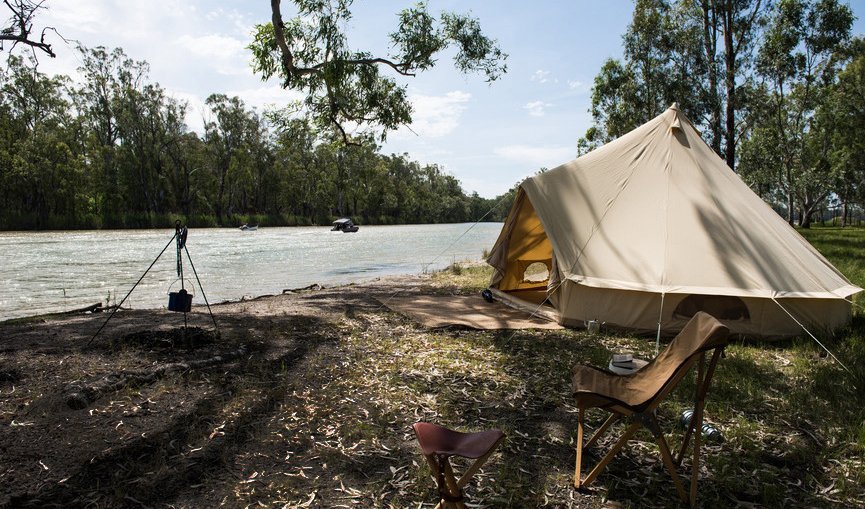
Camping at Barmah National Park, on the Murray River. (Photo credit: Emily Godfrey)
Recommend: All year
Australia’s longest navigable river runs through three states, from NSW and through Victoria before flowing into the Southern Ocean in South Australia. The Victorian section is hugely popular with campers and outdoor enthusiasts for many reasons: the amount of free (and paid) campsites along the river means no matter where you are, it rarely feels crowded; the water activities available (canoeing and kayaking to water skiing or riding on an historic paddle steamer); the fishing (1500km of waterfront between Wodonga and the South Oz border, according to Parks Vic – remember to also purchase a fishing licence); swimming at some of the river’s beaches near Albury-Wodonga; and all the on-ground activities surrounding it (walking, MTB, cycle touring, etc.). Add in the easy access, and you have the ideal a family camping destination.
The Murray River meanders through a range of landscapes as it makes it way through Victoria. From the alpine regions of the Upper Murray (one of our favourite parts of the river) to the more open and arid Mallee region around Mildura, camping at different spots along the Murray is a fantastic way to see how the river and its environs change – and how the river forms such a huge part of each region you camp at. The sheer number of state parks and national parks that abut the mighty waterway allow for a variety of campsites; the Upper Murray is a brilliant kick-off point for any camping road trip along the river, with the campsites at Jingellic Bend (accessed via Shelley Road, off the Murray Valley Highway), Bullock Flat and Burrowye Bend offering a more remote feel. These campsites are quite popular mainly because they offer fantastic put-in points for canoes/kayaks, but are worth the little extra effort to get there. The Kurrajongs (in the northern section of Mount Lawson State Park – a park that also offers plenty of hikes and bush-based camping) is a large campsite further west of Burrowye Bend on the river that has similar watercraft attractions, along with more facilities.
Venture slightly further west to Mount Granya State Park and you not only have an awesome riverside campsite at Cotton Tree Creek, but access to the 10.4km-return hike that leads to the summit of Mount Granya, via pretty Granya Falls. Continue to Albury and you start to access some of the Murray’s famous beaches – as well as get the chance to restock camp supplies in the supermarkets there – before following the river further on its westward journey.
The region centred around Mildura is our other favourite Murray River destination; the sheer variety of activities on offer here, as well as the cool camping and abundance of wildlife and birdlife, mean you could easily spend two weeks just ambling from campsite to campsite. The reserves surrounding this famous inland city come under the collective of the Murray River Parklands and, although mostly day-use areas, make for the perfect excuse to tackle some town-based camping as you explore them. The reserves offer great paddling and fishing (Murray Cod and Golden Perch are found here – but be aware of catch limits and have your fishing licence) and a couple of days of relaxed exploring here will prove perfect for younger families.
Venture further west following the Murray and you will experience the amazing Mallee region of Victoria – its deserts and wide-open spaces a massive contrast to the rocky, heavily timbered mountains of the Upper Murray at the beginning of your Murray camping journey. With the wide river bordered by huge river red gums, small islands dotting the river itself, and the chance to experience a true outback sunset, finishing off your Murray River camping adventure with a few nights camping at some of the national parks here – Hatta-Kulkyne and Murray-Sunset are must-stays – will be the perfect finish to that big camping adventure.
murrayriver.com.au; visitthemurray.com.au
5. MTB: The Dirty Dozen
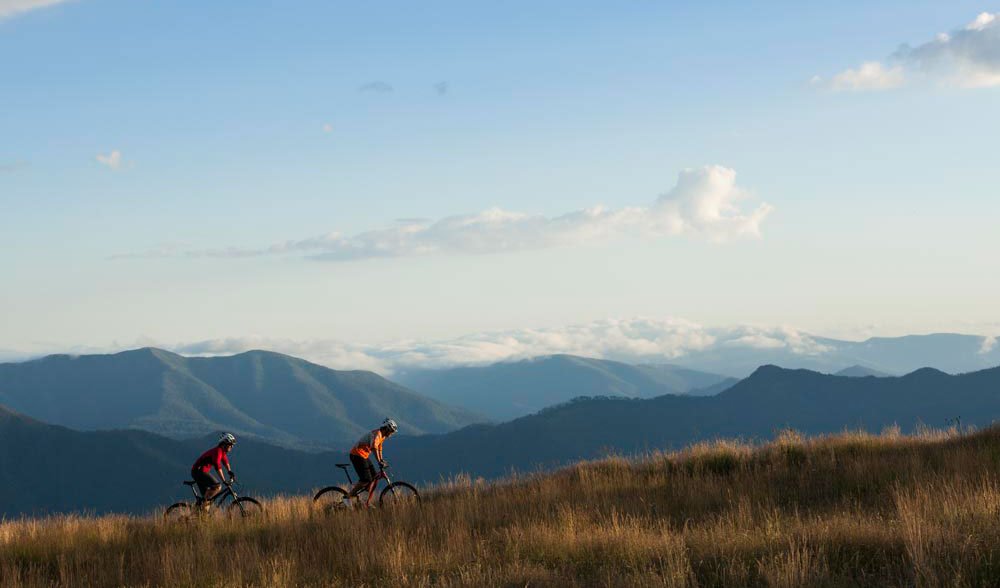
Mountain biking in The Dirty Dozen trails. (Photo credit: Mark Watson)
Recommend: From October-May
Victoria’s High Country is a veritable playground for adventurous types – and none more so than mountain bikers. The Dirty Dozen is – you guessed it – a collection of 12 MTB trails of varying grades found throughout Victoria’s alpine region.
Of course, Mt Buller’s awesome Australian Alpine Epic (the first IMBA-accredited EPIC trail in the southern hemisphere) is included, with its 40km of trails (from Blue to Double Black Diamond graded) guaranteed to offer a riding challenge, as well as take riders through some of the most amazing alpine terrain (from snowgums and treeless alpine tundra to fern-shrouded valleys and huge granite boulders) in Oz.
Other Dirty Dozen members found at Mt Buller include the beautiful 12km Delatite River Trail (intermediate) that takes riders deep down into the river valley, with fun river crossings along the way. For beginners, Mt Buller’s next Dirty Dozen trail is Copperhead, a cool 2.5km flowing descent that takes advantage of the resort’s ski runs on occasion as well.
And then there’s Stonefly. One of the best examples of Glen Jacobs’ World Trail crew and the trail work they are capable of, this Expert-rated 10km trail takes you on a tough looping climb for 6km, before an awesome 4km descent.
There’s more than just Mt Buller to the Dirty Dozen, however. The pretty alpine village of Bright is the centrepoint for three more trails in this group: 24 Carat, Mystic Baker and Morses Creek. The Expert-rated 17km 24 Carat trail lives up to its name; the hand-built singletrack here snakes up and through pine forests and swaps between technical climbs and rushing descents. Mystic Baker, on the other hand, is more accessible with an intermediate grading for its 15km. This trail includes plenty of climbing and descents, as well as an awesome swing bridge crossing of Morses Creek. The same-named Morses Creek Trail rounds out the Bright trio of trails with a 7.6km intermediate ride following the waterway. Of course, to top off Bright’s appeal, there’s the chance to savour some post-ride craft beers at the Bright Brewery…
Mt Beauty is next, with its Big Hill Mountain Bike Park one of Australia’s oldest. The You Beauty Trail is 8km of intermediate riding, with some cool descents and berms. For riders after a serious challenge, the Mt McKay Loop at Falls Creek should be on their list. The 14km Expert-rated loop includes plenty of technical climbing before the grin-inducing downhill return. For the more exploratory rider, Falls Creek’s Historic Huts Loop is a 14km loop that takes in some of the region’s huts, including Wallace’s and Cope Hut.
Rounding out the Dirty Dozen is Beechworth’s beginner-friendly Flame Trees Trail (another World Trail construction) that runs alongside the Beechworth Rail Trail and is the perfect two-wheeled adventure for the whole family. At the moment the trail measures around 10km, but the local MTB club (the aptly named Beechworth Chain Gang) is aiming for a 40km singletrack loop. It’s a great ride now and will only become greater. If you’re more keen, you can stay a few nights longer in Beechworth and tack on the Yellow Arrow Trail, an intermediate 10.5km loop that is found in the fantastic Beechworth MTB Park. Lots of huge granite boulders, rad singletrack and technical challenges make this trail a hoot.
The Dirty Dozen is a brilliant concept – and even more exciting for riders is the fact that this trail network is just the tip of the knobby-tyred iceberg when it comes to riding opportunities in the Garden State.
victoriashighcountry.com.au/cycle/the-dirty-dozen-rides
6. Rock climbing: Mt Arapiles

Christopher Gills rock climbs between stations on Mt Arapiles. (Photo credit: Ross Taylor)
Recommend: All year
Words by Ross Taylor
Driving across the flat patchwork of paddocks that is the Wimmera in Victoria’s west, an anomaly appears just past the small township of Natimuk. Rising from the surrounding wheat fields are what appear to be the ruined walls of a crumbling fortress, its ramparts crusted with moss and topped with a telecom tower.
Closer inspection reveals the walls are far from crumbling, but are formed from walls of perfect sandstone, sometimes rich-orange in colour, other times shades of beautiful marled grey. And amidst the labyrinth of buttresses, pinnacles and gullies roam climbers, who spend their days here sallying forth from the famous climbers’ campground of the Pines to climb some of Arapiles’ 3000-plus routes.
Arapiles – or ‘the Mount’, as it is known to locals – is revered amongst climbers the world over. Every season they make their way here to pay homage to its exceptional routes and spend time dirtbagging (living cheaply) in the dust of the Pines. They come to climb some of the world’s most famous routes. Probably the most famous is Punks in the Gym, a wall of sheer, almost holdless orange sandstone that was first climbed by the legendary German climber Wolfgang Gullich in 1986. Back then it was the world’s hardest climb, and the first to be given the mythical grade of 32 (the higher the number the harder the climb). Not far behind in the fame stakes, and more achievable for most climbers, is Kachoong (21), a supremely photogenic route that climbs through a 3m roof. Climbers love to hang from the lip of the roof, dangling above a sea of paddocks, and have their photo taken.
While these routes are iconic, what really makes Arapiles unique amongst the world’s climbing destinations is the quality of its easy routes. At most areas the easier climbs tend to be low-angled, on poor rock and technically uninteresting. However, at Arapiles the rock has formed such that even the easier routes are on exceptional rock and have interesting, gymnastic climbing on beautifully formed holds. Some these easy climbs are incredibly famous: the long, gentle ramble of Tiptoe Ridge (3), which is often soloed at night under a full moon; Agamemnon (8), a chimney-climb that involves pushing with your hands and feet on two opposing walls; and the Bard (12), a wild and exposed romp up the front of a massive, 120m-high buttress overlooking the Pines that has been terrifying beginners since it was first climbed in the 60s.
A rapiles is a bastion of traditional climbing, a style where climbers place protection (in case they fall) in the rock’s natural features – cracks are fitted with little chocks or expanding devices. Because Arapiles has so many wonderful easy routes that can be naturally projected, it is one of the world’s premier places to learn how to trad climb. Indeed, generations of Oz and NZ’s best climbers learnt their craft at Arapiles before going on to climb all around the globe.
chockstone.org/arapiles/arapiles.htm
Fact file
For all things Victoria see visitvictoria.com
You need a camping permit in some national parks. See parkweb.vic.gov.au
For a fishing licence see agriculture.vic.gov.au/fisheries/recreational-fishing/fishing-licence
READ MORE:
- Weekend trip: East coast mountain bike road trip
- Wilsons Promontory, Victoria
- Gippsland: Victoria’s wilderness frontier
